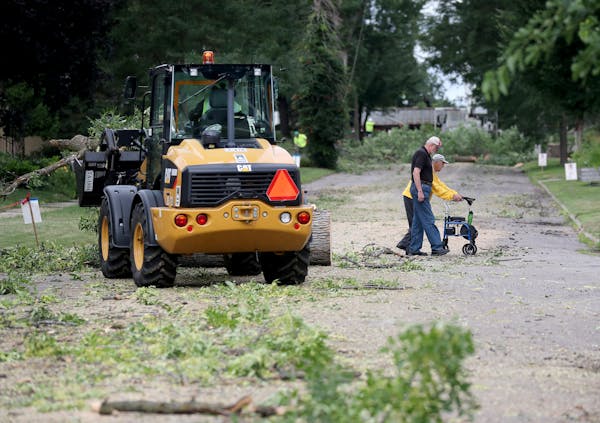As Minnesota's ash trees fall to the invasion of emerald ash borer in the next decade, the forest that borders the 72-mile stretch of the Mississippi River in the Twin Cities metro area is expected to lose one-fifth of its canopy.
Turns out that's not all bad.
Conservation groups that work in the 54,000-acre Mississippi National River and Recreation Area are using that environmental disaster to thwart a much larger one on the way — climate change.
By replacing ash with other kinds of trees, as well as bushes and other plants, they hope to establish a forest that is more likely to thrive in a future of higher average temperatures and much more erratic precipitation.
"We thought we could stack the deck," said Katie Nyberg, executive director of the Mississippi Park Connection, the nonprofit advocacy and fundraising partner with the federal recreation area. "Rather than waiting for the [ash] trees to die and the buckthorn to come in, and saying 'Oh, what do we do now?' "
In fact, the impending ash borer crisis has brought together government land managers and conservation groups all along the river to share resources and think about the forest of the future, she said.
That's what brought David Woods from the nonprofit Urban Roots and a crew of diggers from the Conservation Corps of Minnesota & Iowa out in the rain last week at Pig's Eye Regional Park east of downtown St. Paul. They picked through a horse trough full of tiny trees tipped with new growth, including cottonwood and tamarack, which are suited to the wet river bottom region of the park.
Mary Hammes, director of stewardship for the Mississippi Park Connection, said that in all, the Mississippi recreation area will lose half a million ash trees along the river corridor. With $1 million in grants and donations, the Park Connection and its partners will plant some 15,000 trees to begin replacing them.
With extra care and attention — and some protection from deer — Hammes said she hopes 60 percent of the trees will survive, a much higher rate than would occur naturally. Over time, they too will reproduce, slowly creating stands that will replace the ash trees as they die off.
The loss of canopy, she said, "is where the sun comes in," allowing the tiny seedlings to grow.
15 billion trees
The long anticipated ash borer infestation is now well underway in Minnesota. The invasive insect, which has already decimated the ash trees in Michigan, is felling trees along neighborhood boulevards and parks throughout Minneapolis, St. Paul and surrounding communities.
Lee Frelich, a forestry professor at the University of Minnesota, said the state as a whole will likely lose virtually all of its ash, about 8 percent of the state's total population of 15 billion trees. Based on losses elsewhere, he said, some 99 percent of the ash trees will die in the southern half of the state. Those that are at least 50 miles north of the Twin Cities will survive the next few decades, but only as long as winter temperatures continue to drop to 30 degrees below zero. The bugs don't survive those cold temperatures.
In Michigan, he said white ash, one of the three species of ash, are surviving much better than its green and black siblings.
"That's great news," Frelich said. A few green and black ash trees also sometimes survive infestations, creating hope that new resistant genetic strains can be developed from the survivors over time. That's the same strategy that saved the elm trees since the onslaught of Dutch elm disease.
But until then, land managers along the Mississippi corridor will have to plant something else.
'Cool ecological area'
In Spring Lake Park in Dakota County, which lies along Mississippi River floodplains, managers are bringing back the oak savanna that used to make up some parts of the region. They're relying on bur oaks that will thrive in warmer temperatures, but they're also bringing in Kentucky coffeetrees, which are at the northern edge of their current natural range in Minnesota.
This year, park managers have planted 1,300 trees, said Scott Hagen, a natural resource specialist with Dakota County, plus ferns, grasses, bushes and flowers that will keep buckthorn out of the understory until other trees fill in.
"It will go a long ways in getting diversity going and established before the ash trees are gone," Hagen said.
Woods, of Urban Roots, said the goal upriver, in the park areas intertwined with St. Paul's industrial riverfront, is a "high quality floodplain forest."
Despite the gritty neighborhood of parking lots, railroad tracks and industrial sites, "it's a really cool ecological area," he said. The area around his planting site last week is riddled with underground streams that supply the towering cottonwoods. It drains to Pig's Eye Lake, which contains a heron rookery island.
And the entire corridor is one of the nation's primary flyways for migrating birds.
Still, said Frelich, the ash tree is a sore loss. There's almost no tree species as tolerant of temperatures and location as the ash, he said, especially the green ash that dominates the river bottoms along the Mississippi.
"It would be a very resilient species to have," he said.
Josephine Marcotty • 612-673-7394

Want to share info with the Star Tribune? How to do it securely

'Safe recovery sites' would offer syringes, naloxone and more to people using drugs. The plan could be in peril.
New Minnesota GOP leaders seek peace with party's anti-establishment wing

Who is Republican Lisa Demuth, Minnesota's first House speaker of color?

